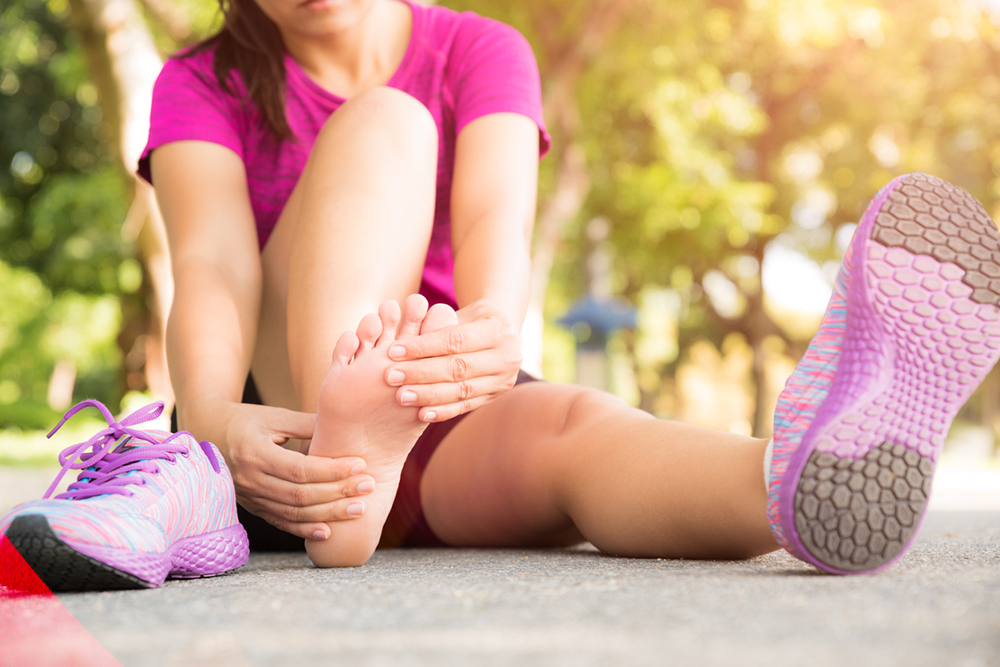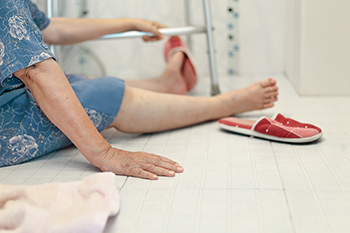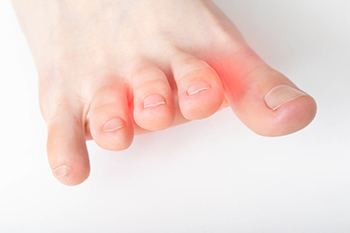
 Foot ulcers are open wounds on the feet resulting from skin breakdown. They may be deep, discolored sores that discharge pus, affecting deeper layers of the skin, and potentially spreading to muscles, tendons, or bones. Often caused by injury, friction, or pressure, ulcers are more likely to develop in people who have diabetes and peripheral neuropathy, which reduces foot sensation and can impede skin healing, raising ulcer risks. These ulcers can be painful. Untreated foot ulcers can lead to infections and complications and require serious medical intervention. To prevent ulcers, wear well-fitting shoes and regularly check your feet. If you have foot wounds, it is suggested that you seek prompt examination and treatment from a podiatrist.
Foot ulcers are open wounds on the feet resulting from skin breakdown. They may be deep, discolored sores that discharge pus, affecting deeper layers of the skin, and potentially spreading to muscles, tendons, or bones. Often caused by injury, friction, or pressure, ulcers are more likely to develop in people who have diabetes and peripheral neuropathy, which reduces foot sensation and can impede skin healing, raising ulcer risks. These ulcers can be painful. Untreated foot ulcers can lead to infections and complications and require serious medical intervention. To prevent ulcers, wear well-fitting shoes and regularly check your feet. If you have foot wounds, it is suggested that you seek prompt examination and treatment from a podiatrist.
Wound care is an important part of dealing with diabetes. If you have diabetes and a foot wound or would like more information about wound care for diabetics, consult with Dr. Robert Hope of Riverside Podiatry. Our doctor will assess your condition and provide quality foot and ankle treatment.
What Is Wound Care?
Wound care is the practice of taking proper care of a wound. This can range from the smallest to the largest of wounds. While everyone can benefit from proper wound care, it is much more important for diabetics. Diabetics often suffer from poor blood circulation which causes wounds to heal much slower than they would in a non-diabetic.
What Is the Importance of Wound Care?
While it may not seem apparent with small ulcers on the foot, for diabetics, any size ulcer can become infected. Diabetics often also suffer from neuropathy, or nerve loss. This means they might not even feel when they have an ulcer on their foot. If the wound becomes severely infected, amputation may be necessary. Therefore, it is of the utmost importance to properly care for any and all foot wounds.
How to Care for Wounds
The best way to care for foot wounds is to prevent them. For diabetics, this means daily inspections of the feet for any signs of abnormalities or ulcers. It is also recommended to see a podiatrist several times a year for a foot inspection. If you do have an ulcer, run the wound under water to clear dirt from the wound; then apply antibiotic ointment to the wound and cover it with a bandage. Bandages should be changed daily and keeping pressure off the wound is smart. It is advised to see a podiatrist, who can keep an eye on it.
If you have any questions please feel free to contact our our offices located in Tuscaloosa, and Fayette, AL. We offer the newest diagnostic and treatment technologies for all your podiatric needs.
 People who participate in running or jogging may experience pain in their big toe. The main joint in the big toe can be prone to undergoing substantial forces while running. It is known as the MTP, or metatarsophalangeal, joint. As the body shifts between the heel and toes while running, the weight can shift to the big toe, which is used as a lever for pushing off. The sesamoid bones are located under the MTP joints, and are as small as sesame seeds. They are prone to injury when they are overworked, and the pain can radiate to the big toe. Additionally, having arthritis in the MTP joint may lead to toe pain, and the affected area may feel stiff. This is known to become worse with age, and mild relief may be felt when the correct shoes are worn. If you have pain in your big toe, it is suggested that you confer with a podiatrist who can offer you additional relief options.
People who participate in running or jogging may experience pain in their big toe. The main joint in the big toe can be prone to undergoing substantial forces while running. It is known as the MTP, or metatarsophalangeal, joint. As the body shifts between the heel and toes while running, the weight can shift to the big toe, which is used as a lever for pushing off. The sesamoid bones are located under the MTP joints, and are as small as sesame seeds. They are prone to injury when they are overworked, and the pain can radiate to the big toe. Additionally, having arthritis in the MTP joint may lead to toe pain, and the affected area may feel stiff. This is known to become worse with age, and mild relief may be felt when the correct shoes are worn. If you have pain in your big toe, it is suggested that you confer with a podiatrist who can offer you additional relief options.
Toe pain can disrupt your daily activities. If you have any concerns, contact Dr. Robert Hope of Riverside Podiatry. Our doctor can provide the care you need to keep you pain-free and on your feet.
What Causes Toe Pain?
Most severe toe pain is caused due to a sports injury, trauma from dropping something heavy on the toe, or bumping into something rigid. Other problems can develop over time for various reasons.
Toe pain can be caused by one or more ailments. The most common include:
When to See a Podiatrist
Diagnosis
In many cases the cause of toe pain is obvious, but in others, a podiatrist may want to use more advanced methods to determine the problem. These can range from simple visual inspections and sensation tests to X-rays and MRI scans. Prior medical history, family medical history, and any recent physical traumatic events will all be taken into consideration for a proper diagnosis.
Treatment
Treatments for toe pain and injuries vary and may include shoe inserts, padding, taping, medicines, injections, and in some cases, surgery. If you believe that you have broken a toe, please see a podiatrist as soon as possible.
If you have any questions please feel free to contact our our offices located in Tuscaloosa, and Fayette, AL. We offer the newest diagnostic and treatment technologies for all your podiatric needs.
 Studies show that falling is the No. 1 cause of injury-related deaths in people ages 65 and older. Experts believe that it may be possible to help prevent falling by addressing three concerns. They are weak stabilizer muscles, poor core strength, and balance problems. Strengthening stabilizer muscles in the hips and core muscles in the abdomen improves the ability to stand up and move. Balance, reflexes, and coordination diminish over time, which makes it easier to trip and reduces the ability to catch yourself if you do. Staying active is a good way to prevent falling, as a sedentary lifestyle further weakens the muscles. Performing a series of exercises to rebuild the strength in weakened muscles can help. In addition, exercises to improve balance can help with stability. Falls also may be caused by other physical ailments, such as arthritis, peripheral neuropathy, and vision problems. Any of these conditions can further increase the risk of falling. For guidance and information on suitable methods to help prevent falls, it is suggested that you consult a podiatrist.
Studies show that falling is the No. 1 cause of injury-related deaths in people ages 65 and older. Experts believe that it may be possible to help prevent falling by addressing three concerns. They are weak stabilizer muscles, poor core strength, and balance problems. Strengthening stabilizer muscles in the hips and core muscles in the abdomen improves the ability to stand up and move. Balance, reflexes, and coordination diminish over time, which makes it easier to trip and reduces the ability to catch yourself if you do. Staying active is a good way to prevent falling, as a sedentary lifestyle further weakens the muscles. Performing a series of exercises to rebuild the strength in weakened muscles can help. In addition, exercises to improve balance can help with stability. Falls also may be caused by other physical ailments, such as arthritis, peripheral neuropathy, and vision problems. Any of these conditions can further increase the risk of falling. For guidance and information on suitable methods to help prevent falls, it is suggested that you consult a podiatrist.
Preventing falls among the elderly is very important. If you are older and have fallen or fear that you are prone to falling, consult with Dr. Robert Hope of Riverside Podiatry. Our doctor will assess your condition and provide you with quality advice and care.
Every 11 seconds, an elderly American is being treated in an emergency room for a fall-related injury. Falls are the leading cause of head and hip injuries for those 65 and older. Due to decreases in strength, balance, senses, and lack of awareness, elderly persons are very susceptible to falling. Thankfully, there are a number of things older persons can do to prevent falls.
How to Prevent Falls
Some effective methods that older persons can do to prevent falls include:
Falling can be a traumatic and embarrassing experience for elderly persons; this can make them less willing to leave the house, and less willing to talk to someone about their fears of falling. Doing such things, however, will increase the likelihood of tripping or losing one’s balance. Knowing the causes of falling and how to prevent them is the best way to mitigate the risk of serious injury.
If you have any questions please feel free to contact our offices located in Tuscaloosa, and Fayette, AL and Fayette, AL. We offer the newest diagnostic and treatment technologies for all your podiatric needs.
 Morton’s neuroma, known as intermetatarsal neuroma, is an inflamed nerve in the ball of the foot, typically behind the third and fourth toes. It can occur from wearing tight shoes or from having foot deformities. Morton’s neuroma presents itself as pain, swelling, numbness, tingling, or burning of the front of the foot. Those who have had this condition liken it to the feeling of walking on a pebble or rolled-up sock. This nerve is sensitive to excessive weight on the foot and scar tissue can form around the nerve and sometimes enlarge it. Those who wear high heels or tight-fitting shoes are susceptible to this condition. Treatments vary by the severity of Morton's neuroma. Resting the foot, cushioning the ball of the foot with padding, and wearing orthotics to take pressure off of the nerve can help. If more conservative treatment does not relieve discomfort, surgery can be performed to remove the inflamed nerve segment. If you are suffering from pain in your midfoot, it is suggested that you make an appointment with a podiatrist for a proper diagnosis and a treatment plan that is customized to your situation.
Morton’s neuroma, known as intermetatarsal neuroma, is an inflamed nerve in the ball of the foot, typically behind the third and fourth toes. It can occur from wearing tight shoes or from having foot deformities. Morton’s neuroma presents itself as pain, swelling, numbness, tingling, or burning of the front of the foot. Those who have had this condition liken it to the feeling of walking on a pebble or rolled-up sock. This nerve is sensitive to excessive weight on the foot and scar tissue can form around the nerve and sometimes enlarge it. Those who wear high heels or tight-fitting shoes are susceptible to this condition. Treatments vary by the severity of Morton's neuroma. Resting the foot, cushioning the ball of the foot with padding, and wearing orthotics to take pressure off of the nerve can help. If more conservative treatment does not relieve discomfort, surgery can be performed to remove the inflamed nerve segment. If you are suffering from pain in your midfoot, it is suggested that you make an appointment with a podiatrist for a proper diagnosis and a treatment plan that is customized to your situation.
Morton’s neuroma is a very uncomfortable condition to live with. If you think you have Morton’s neuroma, contact Dr. Robert Hope of Riverside Podiatry. Our doctor will attend to all of your foot care needs and answer any of your related questions.
Morton’s Neuroma
Morton's neuroma is a painful foot condition that commonly affects the areas between the second and third or third and fourth toe, although other areas of the foot are also susceptible. Morton’s neuroma is caused by an inflamed nerve in the foot that is being squeezed and aggravated by surrounding bones.
What Increases the Chances of Having Morton’s Neuroma?
Morton’s neuroma is a very treatable condition. Orthotics and shoe inserts can often be used to alleviate the pain on the forefront of the feet. In more severe cases, corticosteroids can also be prescribed. In order to figure out the best treatment for your neuroma, it’s recommended to seek the care of a podiatrist who can diagnose your condition and provide different treatment options.
If you have any questions please feel free to contact our offices located in Tuscaloosa, and Fayette, AL and Fayette, AL. We offer the newest diagnostic and treatment technologies for all your podiatric needs.